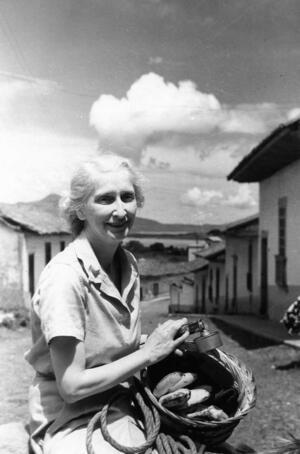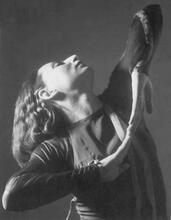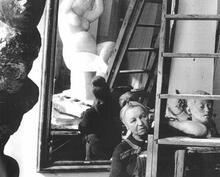Doris Rosenthal
Doris Rosenthal’s artwork, inspired by her travels around the world, forged links between cultures and brought new aesthetics to design. Rosenthal studied at the New York Art Students League and taught at Columbia Teachers College while pursuing her art. She had her first solo show at Morton Galleries in 1928, before publishing her acclaimed Prim-Art Series, prints based on graphic images from cultures around the world arranged by subject rather than region. The series earned her two Guggenheim fellowships, in 1931 and 1936, which she used to travel to Mexico. There, she traveled alone to remote regions, capturing the subtleties of daily life and researched Mexican art traditions. Between trips, she taught art at James Monroe High School in the Bronx before retiring to Mexico.
Born in Riverside, California, around 1895, Rosenthal was raised on a ranch by her parents, Emil J. and Anne (Unruh) Rosenthal. She won a scholarship in 1918 to study with George Bellows and John Sloane at the New York Art Students League.
Rosenthal was educated at Los Angeles State Teachers College, followed by graduate studies at Columbia University. She then worked briefly as a commercial designer of silks, saving enough money to tour Europe, where she continued the study of painting from 1920 to 1922. After returning from Europe, she married Jack Charash, a theater agent, and her early work depicted backstage scenes and New York department store dressing rooms. While teaching at Columbia Teachers College from 1924 to 1931, Rosenthal actively pursued her painting career and had her first solo show at Morton Galleries in 1928.
The Prim-Art Series
In the late 1920s, Rosenthal published a unique series of unbound plates, The Prim-Art Series. These portfolios consist of graphic images from all over the world executed by Rosenthal and based on designs acquired from objects in museums. Arranged around thematic motifs such as transportation, costumes, and birds rather than by country or time, the portfolios were a teaching tool and a resource for the professional designer. Each portfolio came with a lesson plan and method of application. The transportation portfolio included images of Russian carriages, railroad cars, bicycles, balloons, Egyptian triumphal cars, planes and zeppelins, representing everything from the fantastical to flash-in-the-pan industrial designs. Delightfully random, the portfolios were part of an emerging modernist art that looked to the so-called primitive for inspiration, hoping to return art to simple production unpolluted by industrialism and the factory.
Work in Mexico
The Prim-Art portfolios were instrumental in winning her two Guggenheim fellowships, in 1931 and 1936, to travel to Mexico. These trips changed the course of her life and art. By 1934, Rosenthal was a nationally and internationally recognized “regionalist” painter of Mexican themes, noted for her skill in composition and draughtsmanship. Articles describing “the Gringa” painter appeared frequently. She maintained a studio in Silvermine, Norwalk, Connecticut, while teaching art at James Monroe High School in the Bronx. In the summers, Rosenthal traveled by burro into the remote states of Mexico, carrying sketch pads and a Flit gun, and using tequila as a fixative when necessary. Returning from her thirteenth summer in Latin America in 1944, Rosenthal compared the devastating effects of the military dictatorship on the arts in Guatemala to the flourishing Mexican art tradition. She concluded, “I feel pretty certain that systemization is sterilization as far as the arts go.” Two months later, contributing to the national debate on art education in the United States, she warned against bureaucracy, echoing her earlier strong words: “Systemization is the greatest evil.”
Mostly figurative, Rosenthal’s paintings, based on hundreds of sketches from her travels, focus on domestic detail and daily gestures, inviting the viewer to experience the intricacies of ordinary life with the Mexican Indians, especially the lives of children. The Sanchezes of Cherán, Mexico, was one of the families that accepted Rosenthal into their homes. Their sons are depicted in “TOPS,” one of her most famous paintings. Another painting, “The Source,” shows Tarascan Indians bathing in water piped for miles in hollowed-out tree trunks. Mexican critic Guillermo Rivas wrote of her work in 1934: “Doris Rosenthal is not striving to escape life, but rather does she go out to meet it.” Rosenthal sought not to work as a tourista-artist, capturing mere picturesque impressions of a place, but to engage in the culture, coming to a deeper appreciation of people’s everyday lives.
By the time Doris Rosenthal died on November 26, 1971, she had made Oaxaca, Mexico, her permanent home.
Selected Works by Doris Rosenthal
Pertaining to Birds: How to Use Bird Motifs in Design, compiler (1929).
Pertaining to Boats, compiler (1928).
Pertaining to Costume: How to Use Historic Costumes in Design, compiler (1930).
Pertaining to Flowers and Trees: How to Use Nature Motifs in Design, compiler (1930).
Pertaining to Man: How to Use Figure Motifs in Design, compiler (1930);.
Pertaining to Transportation: How to Use Transportation Motifs in Design, compiler (1929).
Prim-Art Series. Vol. 1: Animal Motifs (1926).
“‘System Is Greatest Evil’: What Is Wrong with American Art Education?” The Arts Digest (August 1, 1944): 12.
“Doris Rosenthal: Mentor Plus Mexico.” Art News (February 15, 1943): 20.
“Doris Rosenthal Paints Mexico in an Original Idiom.” Art News (April 1, 1939): 13.
“Doris ‘the Gringa’ in Guatemala.” American Artist 8, no. 6 (June 1944): 22–26.
Henkes, Robert. American Women Painters of the 1930’s and 1940’s: The Lives and Works of Ten Artists (1991).
Obituary. NYTimes, November 28, 1971, 72:7.
Pagano, Grace, ed. Encyclopaedia Britannica Collection of Contemporary American Painting (1946).
Rosenthal, Doris. Papers, 1932–1965. Archives of American Art, Smithsonian Institution, Washington, D.C..
“Seen in Old Mexico.” Art Digest (March 1, 1941): 9.
“Shows Fruits of a Scholarship in Mexico.” The Art Digest (February 15, 1934): 29.
WWIAJ (1928).
WWWIA 5.












